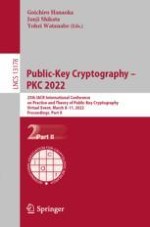2022 | OriginalPaper | Buchkapitel
On Pairing-Free Blind Signature Schemes in the Algebraic Group Model
verfasst von : Julia Kastner, Julian Loss, Jiayu Xu
Erschienen in: Public-Key Cryptography – PKC 2022
Aktivieren Sie unsere intelligente Suche, um passende Fachinhalte oder Patente zu finden.
Wählen Sie Textabschnitte aus um mit Künstlicher Intelligenz passenden Patente zu finden. powered by
Markieren Sie Textabschnitte, um KI-gestützt weitere passende Inhalte zu finden. powered by
